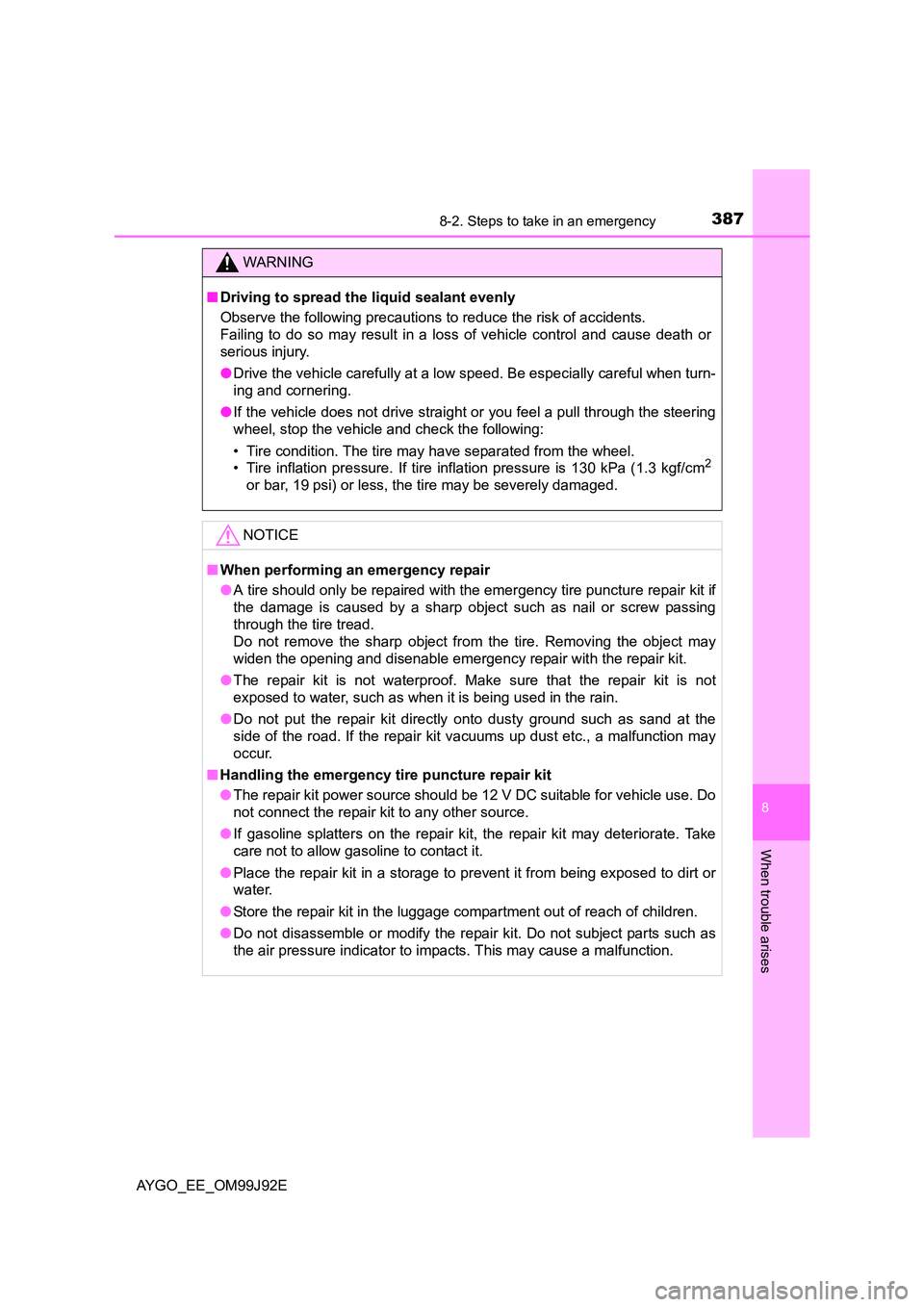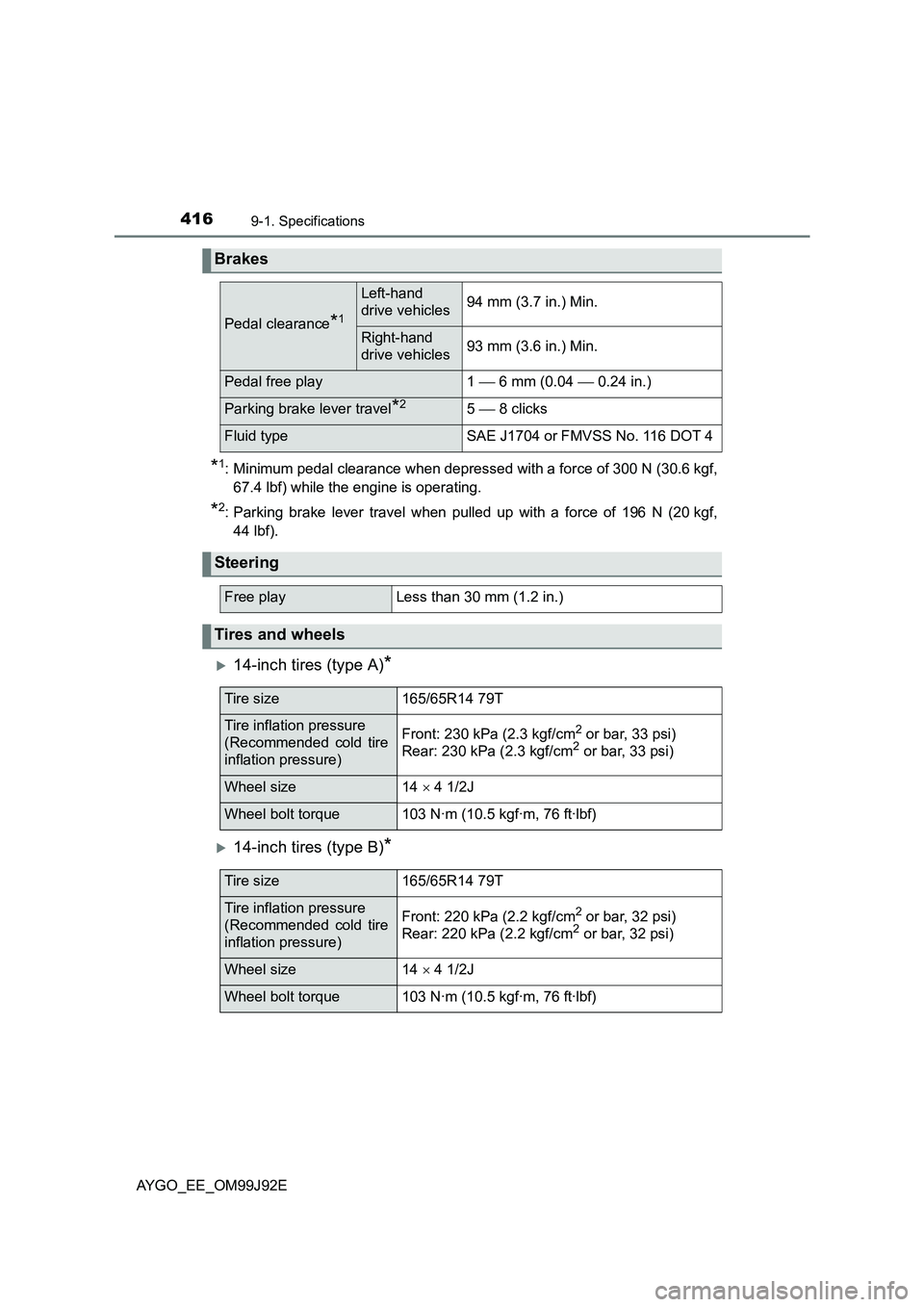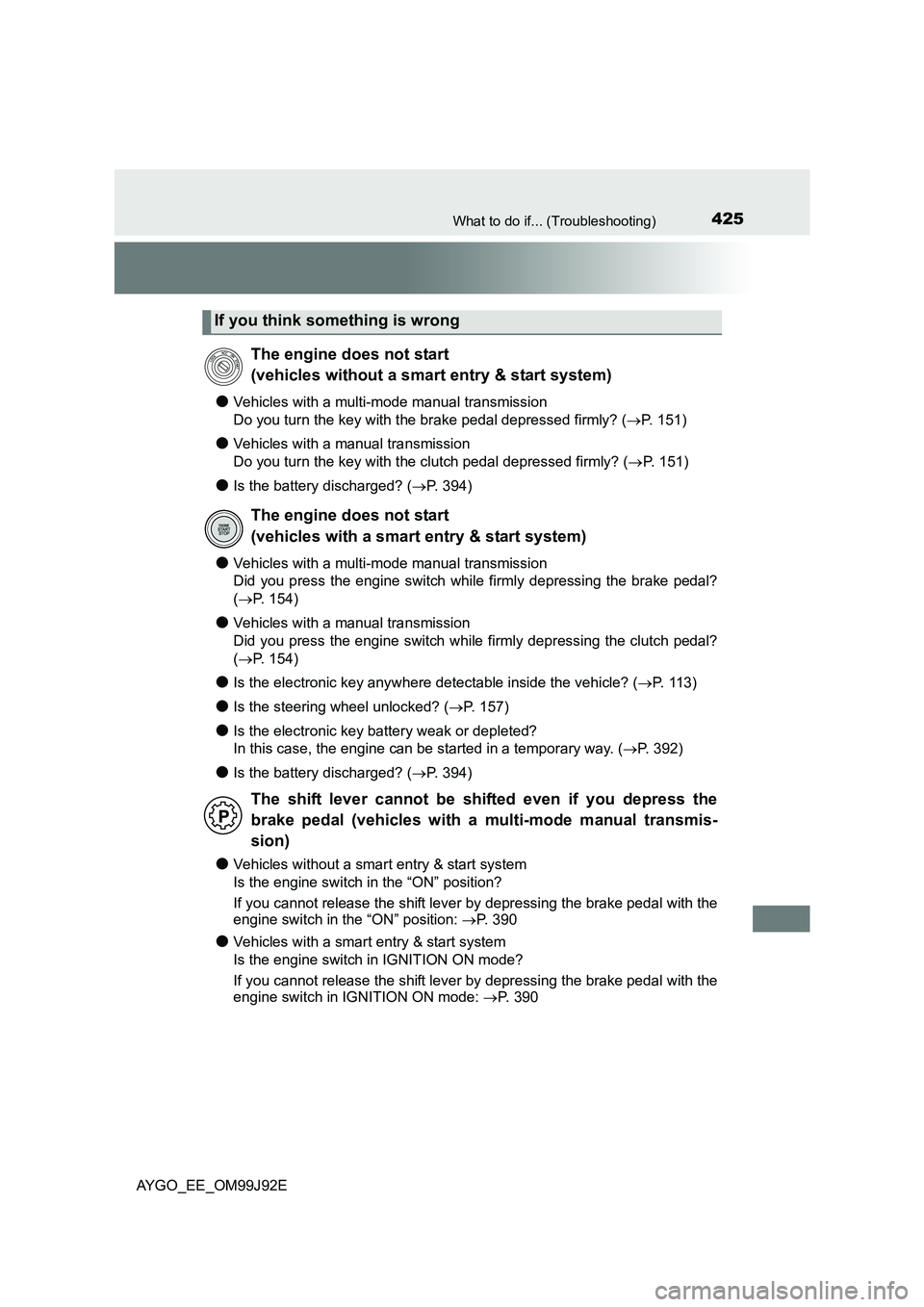Page 387 of 440

3878-2. Steps to take in an emergency
8
When trouble arises
AYGO_EE_OM99J92E
WARNING
■ Driving to spread the liquid sealant evenly
Observe the following precautions to reduce the risk of accidents.
Failing to do so may result in a loss of vehicle control and cause death or
serious injury.
● Drive the vehicle carefully at a low speed. Be especially careful when turn-
ing and cornering.
● If the vehicle does not drive straight or you feel a pull through the steering
wheel, stop the vehicle and check the following:
• Tire condition. The tire may have separated from the wheel.
• Tire inflation pressure. If tire inflation pressure is 130 kPa (1.3 kgf/cm2
or bar, 19 psi) or less, the tire may be severely damaged.
NOTICE
■ When performing an emergency repair
● A tire should only be repaired with the emergency tire puncture repair kit if
the damage is caused by a sharp object such as nail or screw passing
through the tire tread.
Do not remove the sharp object from the tire. Removing the object may
widen the opening and disenable emergency repair with the repair kit.
● The repair kit is not waterproof. Make sure that the repair kit is not
exposed to water, such as when it is being used in the rain.
● Do not put the repair kit directly onto dusty ground such as sand at the
side of the road. If the repair kit vacuums up dust etc., a malfunction may
occur.
■ Handling the emergency tire puncture repair kit
● The repair kit power source should be 12 V DC suitable for vehicle use. Do
not connect the repair kit to any other source.
● If gasoline splatters on the repair kit, the repair kit may deteriorate. Take
care not to allow gasoline to contact it.
● Place the repair kit in a storage to prevent it from being exposed to dirt or
water.
● Store the repair kit in the luggage compartment out of reach of children.
● Do not disassemble or modify the repair kit. Do not subject parts such as
the air pressure indicator to impacts. This may cause a malfunction.
Page 403 of 440
4038-2. Steps to take in an emergency
8
When trouble arises
AYGO_EE_OM99J92E
WARNING
■ When attempting to free a stuck vehicle
If you choose to push the vehicle back and forth to free it, make sure the
surrounding area is clear to avoid striking other vehicles, objects or people.
The vehicle may also lunge forward or lunge back suddenly as it becomes
free. Use extreme caution.
■ When shifting the shift lever (vehicles with a multi-mode manual trans-
mission)
Be careful not to shift the shift lever with the accelerator pedal depressed.
This may lead to unexpected rapid acceleration of the vehicle that may
cause an accident resulting in death or serious injury.
NOTICE
■ To avoid damaging the transmission and other components
● Avoid spinning the wheels and depressing the accelerator pedal more
than necessary.
● If the vehicle remains stuck even after these procedures are performed,
the vehicle may require towing to be freed.
Page 406 of 440
4069-1. Specifications
AYGO_EE_OM99J92E
Maintenance data (fuel, oil level, etc.)
*1: Unladen vehicle
*2: Vehicles with raised vehicle height
Dimensions
Overall length3455 mm (136.0 in.)
Overall width1615 mm (63.6 in.)
Overall height*11460 mm (57.5 in.)
1480 mm (58.3 in.)*2
Wheelbase2340 mm (92.1 in.)
TreadFront1425 mm (56.1 in.)
1420 mm (55.9 in.)*2
Rear1420 mm (55.9 in.)
Gross vehicle mass1240 kg (2733 lb.)
Maximum permissible
axle capacity
Front695 kg (1532 lb.)Rear
Page 416 of 440

4169-1. Specifications
AYGO_EE_OM99J92E
*1: Minimum pedal clearance when depressed with a force of 300 N (30.6 kgf,
67.4 lbf) while the engine is operating.
*2: Parking brake lever travel when pulled up with a force of 196 N (20 kgf,
44 lbf).
�X14-inch tires (type A)*
�X14-inch tires (type B)*
Brakes
Pedal clearance*1
Left-hand
drive vehicles94 mm (3.7 in.) Min.
Right-hand
drive vehicles93 mm (3.6 in.) Min.
Pedal free play1 6 mm (0.04 0.24 in.)
Parking brake lever travel*25 8 clicks
Fluid typeSAE J1704 or FMVSS No. 116 DOT 4
Steering
Free playLess than 30 mm (1.2 in.)
Tires and wheels
Tire size165/65R14 79T
Tire inflation pressure
(Recommended cold tire
inflation pressure)
Front: 230 kPa (2.3 kgf/cm2 or bar, 33 psi)
Rear: 230 kPa (2.3 kgf/cm2 or bar, 33 psi)
Wheel size14 × 4 1/2J
Wheel bolt torque103 N·m (10.5 kgf·m, 76 ft·lbf)
Tire size165/65R14 79T
Tire inflation pressure
(Recommended cold tire
inflation pressure)
Front: 220 kPa (2.2 kgf/cm2 or bar, 32 psi)
Rear: 220 kPa (2.2 kgf/cm2 or bar, 32 psi)
Wheel size14 × 4 1/2J
Wheel bolt torque103 N·m (10.5 kgf·m, 76 ft·lbf)
Page 417 of 440
4179-1. Specifications
9
Vehicle specifications
AYGO_EE_OM99J92E
�X15-inch tires
�XCompact spare tires (if equipped)
*: The tire inflation pressure is indi-
cated on the left-side center pillar.
Tire size165/60R15 77H
Tire inflation pressure
(Recommended cold tire
inflation pressure)
Front: 230 kPa (2.3 kgf/cm2 or bar, 33 psi)
Rear: 230 kPa (2.3 kgf/cm2 or bar, 33 psi)
Wheel size15 × 4 1/2J
Wheel bolt torque103 N·m (10.5 kgf·m, 76 ft·lbf)
Tire sizeT125/70R15 95M, T125/70D15 95M
Tire inflation pressure
(Recommended cold tire
inflation pressure)
420 kPa (4.2 kgf/cm2 or bar, 60 psi)
Wheel size15 × 4B
Wheel bolt torque103 N·m (10.5 kgf·m, 76 ft·lbf)
Page 425 of 440

425What to do if... (Troubleshooting)
AYGO_EE_OM99J92E
●Vehicles with a multi-mode manual transmission
Do you turn the key with the brake pedal depressed firmly? ( →P. 151)
●Vehicles with a manual transmission
Do you turn the key with the clutch pedal depressed firmly? ( →P. 151)
●Is the battery discharged? (→P. 394)
●Vehicles with a multi-mode manual transmission
Did you press the engine switch while firmly depressing the brake pedal?
( →P. 154)
●Vehicles with a manual transmission
Did you press the engine switch while firmly depressing the clutch pedal?
( →P. 154)
●Is the electronic key anywhere detectable inside the vehicle? (→P. 113)
●Is the steering wheel unlocked? (→P. 157)
●Is the electronic key battery weak or depleted?
In this case, the engine can be started in a temporary way. ( →P. 392)
●Is the battery discharged? (→P. 394)
●Vehicles without a smart entry & start system
Is the engine switch in the “ON” position?
If you cannot release the shift lever by depressing the brake pedal with the
engine switch in the “ON” position: →P. 390
●Vehicles with a smart entry & start system
Is the engine switch in IGNITION ON mode?
If you cannot release the shift lever by depressing the brake pedal with the
engine switch in IGNITION ON mode: →P. 390
If you think something is wrong
The engine does not start
(vehicles without a smart entry & start system)
The engine does not start
(vehicles with a smart entry & start system)
The shift lever cannot be shifted even if you depress the
brake pedal (vehicles with a multi-mode manual transmis-
sion)
Page 426 of 440

426What to do if... (Troubleshooting)
AYGO_EE_OM99J92E
●Vehicles without a smart entry & start system
It is locked to prevent theft of the vehicle if the key is removed from the
engine switch. ( →P. 152)
●Vehicles with a smart entry & start system
It is locked automatically to prevent theft of the vehicle. ( →P. 157)
●The auto power off function will be operated if the vehicle is left in ACCES-
SORY or IGNITION ON mode (the engine is not operating) for a period of
time. ( →P. 156)
●The seat belt reminder light is flashing
Are the driver and the front passenger wearing the seat belts? ( →P. 355)
●The brake system warning light is on
Is the parking brake released? ( →P. 166)
Depending on the situation, other types of warning buzzer may also
sound. ( →P. 352)
●When a warning light turns on, refer to P. 352.
The steering wheel cannot be turned after the engine is
stopped
The engine switch is turned off automatically
(vehicles with a smart entry & start system)
A warning buzzer sounds during driving
A warning light turns on
Page 428 of 440

428Alphabetical index
AYGO_EE_OM99J92E
Alphabetical index
A/C..................................... 256, 262
Air conditioning filter.............. 318
Automatic air conditioning
system ................................ 262
Manual air conditioning
system ................................ 256
ABS (Anti-lock Brake
System) .................................. 191
Function ................................ 191
Warning light ......................... 354
Air conditioning filter .............. 318
Air conditioning
system ............................ 256, 262
Air conditioning filter.............. 318
Automatic air conditioning
system ................................ 262
Manual air conditioning
system ............................... 256
Airbag manual on-off
system ...................................... 45
Airbags ....................................... 34
Airbag manual on-off
system .................................. 45
Airbag operating conditions .... 41
Airbag precautions for
your child .............................. 37
Airbag warning light .............. 354
Correct driving posture............ 28
Curtain shield airbag
operating conditions ............. 41
Curtain shield airbag
precautions ........................... 37
General airbag precautions..... 37
Locations of airbags................ 34
Modification and disposal
of airbags.............................. 40
Side airbag operating
conditions ............................. 41
Side airbag precautions .......... 37
Side and curtain shield
airbags operating
conditions ............................. 41
Side and curtain shield
airbags precautions .............. 37
SRS airbags............................ 34
Anchor brackets ........................ 62
Antennas (smart entry &
start system) .......................... 113
Anti-lock brake system
(ABS) ...................................... 191
Function ................................ 191
Warning light ......................... 354
Audio system*......................... 200
Audio input .................... 203, 226
AUX port ....................... 203, 226
Bluetooth® audio................... 242
iPod....................................... 211
Optimal use........................... 204
Portable music player ........... 203
Radio .................................... 206
Steering wheel audio
switch ................................. 202
USB memory ........................ 219
Automatic air conditioning
system .................................... 262
Air conditioning filter ............. 318
Automatic air conditioning
system ............................... 262
Automatic light control
system .................................... 169
AUX port*......................... 203, 226
A